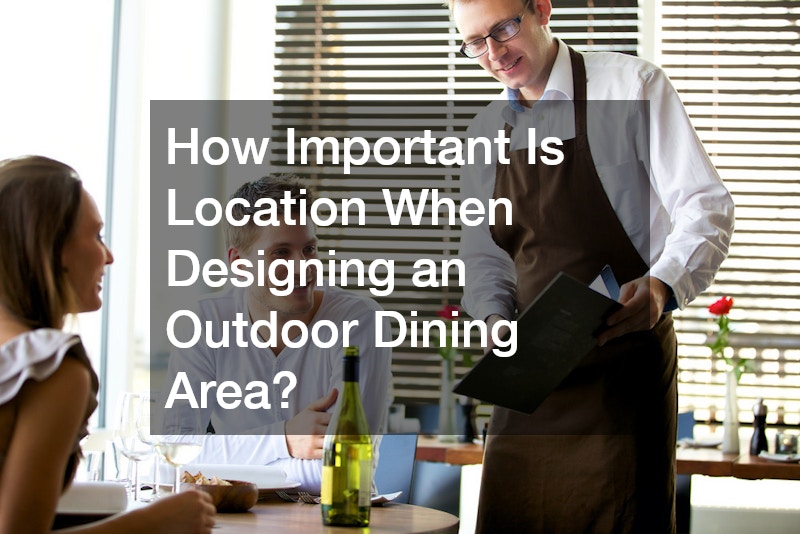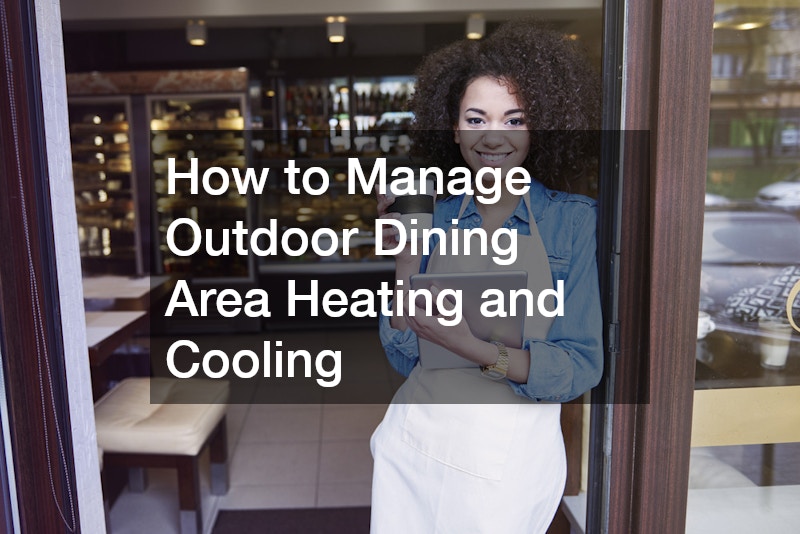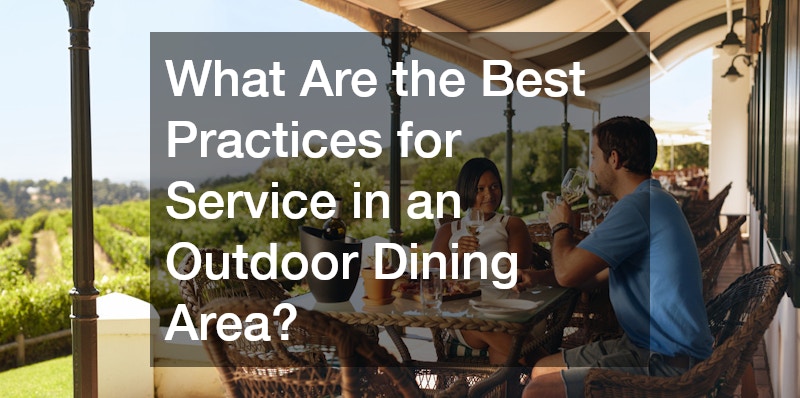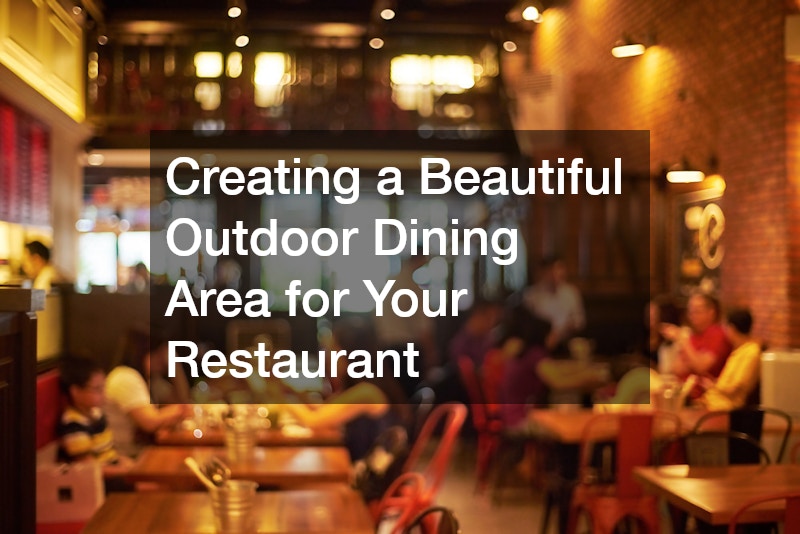
Setting the scene for outdoor dining can completely transform your restaurant’s ambiance, offering guests an experience that goes beyond the meals themselves. Al fresco dining has grown in popularity as patrons seek enjoyable, relaxed environments where they can savor their food in fresh air and pleasant surroundings. A thoughtfully designed outdoor dining space not only increases seating capacity but also enhances the restaurant’s appeal, draws in new customers, and encourages repeat visits.
This article explores essential elements and considerations for creating a charming and functional outdoor dining area, covering everything from location and furniture to ambiance, safety, and service strategies. Additionally, we’ll discuss the tools, services, and supplies that can enhance your space, from commercial outdoor planters to professional pest control services and the right restaurant supply essentials.
How Important Is Location When Designing an Outdoor Dining Area?

The success of an outdoor dining area begins with location. The right spot maximizes visibility, ensures accessibility, and provides a comfortable environment for guests throughout the year. Carefully evaluating the site before investing in furnishings, landscaping, and décor is critical to creating a space that is both practical and inviting.
Assessing Space and Accessibility
Before planning your outdoor area, assess the available space and determine how it can be used efficiently. Consider traffic flow, the proximity of entrances and exits, and connections to the kitchen and restrooms. An accessible layout ensures staff can serve guests quickly and safely while maintaining comfort for diners. Wider pathways and clearly defined seating areas prevent congestion and make the space more welcoming. Using pavers or other durable flooring materials can improve both aesthetics and accessibility while guiding foot traffic throughout the space.
Understanding Local Zoning Laws
Local zoning and permitting regulations play a key role in outdoor dining setups. Different municipalities have specific rules regarding occupancy, noise levels, alcohol service, and structural additions. Consulting with local authorities before designing the space helps avoid costly compliance issues later on. Ensuring that your outdoor area aligns with regulations safeguards the longevity of your investment.
Analyzing Foot Traffic and Visibility
Visibility from streets and walkways can significantly impact the success of an outdoor dining area. High foot traffic areas often attract spontaneous diners, while more secluded locations may appeal to guests seeking privacy. Balancing these factors requires strategic planning, taking into account both exposure and the overall dining experience. Attractive signage, well-placed commercial outdoor planters, and an inviting façade can further enhance your restaurant’s presence.
Evaluating Climate and Weather Patterns
Weather is a decisive factor in outdoor dining. Understanding seasonal temperatures, rainfall patterns, and wind exposure is essential for creating a space that can operate year-round. Investing in a retractable awning allows flexibility, offering shade on hot days and shelter during light rain. Combined with patio heaters, fans, or misting systems, it ensures guest comfort regardless of the season. Planning for climate considerations upfront allows for a resilient outdoor dining area.
Considering Accessibility Needs
Inclusive design benefits all patrons, particularly those with mobility challenges. Ensure pathways, seating, and entrances are wheelchair-friendly, with ramps and smooth surfaces. Adequate spacing between tables enhances both accessibility and comfort, making your restaurant welcoming to every guest. Accessibility improvements also demonstrate social responsibility, which resonates positively with customers.
What Kind of Furniture Should You Choose for an Outdoor Dining Area?

Outdoor furniture plays a critical role in both comfort and style. Choosing pieces that balance durability, practicality, and aesthetics ensures that your investment enhances the overall dining experience.
Choosing Weatherproof Materials
Outdoor furniture must withstand exposure to sun, rain, wind, and temperature fluctuations. Materials like treated hardwood, powder-coated aluminum, synthetic wicker, and teak are excellent choices for durability and longevity. Weatherproof fabrics for cushions and upholstery prevent fading and mildew, maintaining a fresh appearance year-round. Commercial outdoor planters can complement the furniture, adding greenery and natural elements without taking up excessive space.
Selecting Functional and Versatile Furniture
Functionality is key when designing for variable group sizes and different dining experiences. Tables that can be easily rearranged, extended, or combined allow staff to accommodate both intimate meals and larger parties. Multi-purpose seating, such as benches with storage or modular chairs, adds flexibility and maximizes usable space. Selecting restaurant supply-grade furniture ensures durability in high-traffic areas while maintaining a polished aesthetic.
Incorporating Comfortable Seating
Comfortable seating encourages guests to stay longer and enjoy their meals. Ergonomically designed chairs with supportive cushions enhance the dining experience, while tables at appropriate heights ensure ease of use. Consider a mix of seating options, such as banquettes, chairs, and lounge areas, to create varied experiences within the same space.
Matching Aesthetic to Your Restaurant’s Branding
Outdoor furniture should reflect the restaurant’s identity and overall aesthetic. Sleek, modern lines suit contemporary eateries, while rustic wooden tables may complement a farm-to-table concept. Cohesive design strengthens brand recognition and elevates the atmosphere, creating a seamless transition between indoor and outdoor dining. Using pavers, coordinated color schemes, and decorative commercial outdoor planters further reinforces the style.
Considering Storage and Mobility Needs
Furniture that is easy to move or store can adapt to changing weather or event requirements. Stackable chairs, foldable tables, and furniture with wheels allow staff to rearrange seating efficiently. Adequate storage solutions also protect investment during off-hours or winter months, extending the lifespan of your furnishings.
How to Create the Right Ambiance and Atmosphere
Ambiance can make or break an outdoor dining experience. Thoughtful attention to lighting, greenery, sound, and décor ensures guests feel comfortable, relaxed, and engaged throughout their visit.
Using Lighting to Set the Mood
Lighting is not just functional; it shapes the emotional tone of a space. Soft, warm lighting creates an intimate environment, while brighter lights can energize larger, lively gatherings. Layered lighting strategies, such as overhead lights combined with accent and pathway lighting, provide versatility and depth. Commercial electricians can ensure safe installation of lighting systems, including string lights and spotlights, so your space remains both beautiful and compliant.
Adding Greenery and Natural Elements
Plants and natural elements enhance the visual appeal of outdoor dining areas while contributing to a soothing environment. Vertical gardens, potted plants, and commercial outdoor planters provide shade, privacy, and a sense of connection with nature. Seasonal flowers add color and fragrance, enriching the sensory experience for diners. Incorporating tree pruning services ensures that surrounding trees remain healthy and do not interfere with seating or views.
Enhancing with Soundscapes and Music
Background music or ambient soundscapes can elevate the dining experience without overpowering conversation. Subtle music, water features, or gentle wind chimes contribute to a calming atmosphere. Choosing sound levels and styles that complement your restaurant’s theme ensures a harmonious environment.
Crafting Cozy and Intimate Spaces
Creating intimate seating arrangements encourages longer stays and personal interaction. Grouping tables in semi-private areas or incorporating booths, partitions, or planters can create small nooks within a larger space. These design choices cater to diners seeking a cozy experience while maintaining overall flow.
Using Color Schemes and Textures
Colors and textures influence mood and perception of space. Earthy tones and natural textures tend to feel relaxing, while vibrant colors inject energy and vibrancy. Coordinating table settings, cushions, and décor elements with your restaurant’s branding reinforces identity and visual cohesion.
What Are the Best Lighting Options for Outdoor Dining?
Lighting for outdoor dining must combine aesthetics, energy efficiency, and safety. Several modern solutions cater to these needs.
Exploring Solar Lighting Solutions
Solar lighting offers energy efficiency and versatility. Solar-powered lanterns, pathway lights, and decorative fixtures reduce electricity costs and allow flexible placement without complex wiring. Solar options also align with environmentally conscious practices, appealing to eco-minded guests.
Integrating String Lights and Lanterns
String lights and hanging lanterns provide warmth and charm. They are perfect for creating an intimate, whimsical atmosphere, particularly in evening dining settings. Combining different heights and intensities adds visual interest and depth to the space.
Utilizing LED and Energy-Efficient Options
LED lighting is both durable and cost-effective, providing bright, long-lasting illumination. It allows for color and intensity adjustments, enabling restaurant owners to tailor lighting to different times of day or events. Energy-efficient options reduce operating costs while supporting sustainability. Commercial electricians can assist in proper installation to ensure safety and reliability.
Creating Layered Lighting Effects
Layered lighting combines ambient, task, and accent lighting to enhance both function and aesthetic appeal. Overhead lights provide general illumination, while table lamps or spotlighting highlight specific areas. Path and step lighting ensures safety without compromising ambiance.
Addressing Safety with Path and Spot Lighting
Adequate lighting ensures that guests and staff navigate the space safely, preventing accidents and improving visibility. Path lighting, stair illumination, and spotlighting near entrances and exits enhance security and create a welcoming environment.
How to Manage Outdoor Dining Area Heating and Cooling

Climate control is essential to extending the usability of outdoor spaces throughout the year. Offering comfortable temperatures enhances guest satisfaction and encourages repeat visits.
Using Patio Heaters
Patio heaters provide warmth during cooler months or evenings. Available in electric, propane, or natural gas models, they can be strategically placed to cover seating areas without interfering with aesthetics. Heaters also create a cozy atmosphere, inviting diners to linger longer.
Incorporating Mist Systems
Mist systems reduce ambient temperature during hot weather, providing relief for guests in sunny or humid climates. They can be discreetly integrated into overhead structures or retractable awnings, enhancing comfort without distracting from the overall design.
Setting Up Fans and Natural Ventilation
Fans promote air circulation, reducing heat and insects. Ceiling fans or strategically positioned freestanding units improve comfort while maintaining a gentle breeze. Designing seating areas with natural ventilation in mind, such as open-sided pergolas or cross-ventilated layouts, further enhances comfort.
Installing Retractable Awnings and Shades
Retractable awnings protect guests from sun and rain while adding flexibility to your outdoor dining space. They can be extended or retracted depending on weather conditions, enhancing comfort and extending the usability of the area.
Creating Climate Zones for Guest Comfort
Larger dining areas can benefit from designated climate zones. Grouping seating areas with heaters, fans, or shade solutions allows staff to direct guests to the most comfortable spots based on weather conditions. This approach demonstrates attention to detail and improves overall satisfaction.
What Kind of Flooring Should Be Used in an Outdoor Dining Area?
Flooring contributes to both safety and aesthetics. Choosing materials that are durable, slip-resistant, and visually appealing is critical for long-term success.
Choosing Durable and Easy Maintenance Options
Materials such as treated wood, composite decking, pavers, stone, or concrete offer durability and ease of maintenance. They withstand heavy foot traffic, exposure to weather, and cleaning processes without losing their visual appeal. Using a power washing service periodically keeps surfaces clean and prolongs their lifespan.
Comparing Decking vs Paving
Decking adds warmth and a natural feel, ideal for casual or rustic dining settings, while paving provides a clean, sophisticated look suitable for upscale environments. The choice depends on your restaurant’s branding, budget, and desired maintenance level.
Utilizing Slip-Resistant Surfaces
Safety is paramount in outdoor spaces, especially in wet conditions. Slip-resistant pavers or textured finishes reduce the risk of accidents for both guests and staff. Choosing the right surface ensures a safer environment without compromising style.
Considering Aesthetic Versus Practicality
While aesthetics are important, practical considerations such as durability, cleaning, and weather resistance should guide flooring decisions. Balancing beauty and functionality ensures the space remains attractive and operational over time.
Evaluating Cost and Lifespan Balance
Long-term investment in flooring pays off when materials are resilient and require minimal upkeep. Compare upfront costs with projected lifespan and maintenance requirements to select options that are both financially and operationally sustainable.
How to Ensure Safety and Compliance in Outdoor Dining Spaces
Safety and compliance are essential to protect both guests and staff. Adhering to regulations minimizes liability and builds trust with your customers.
Understanding Health and Safety Regulations
Restaurants must comply with local health and safety regulations, including food handling, sanitation, and occupancy limits. Outdoor dining areas are subject to the same rules as indoor spaces, with additional considerations for structural safety and weather protection.
Ensuring Structural Integrity
Canopies, pergolas, decks, and other structures must be professionally designed and installed to meet safety standards. Regular inspections and maintenance prevent hazards from developing over time, protecting guests and staff. Consulting commercial electricians ensures that outdoor electrical systems are safely installed and compliant.
Providing Adequate Spacing and Flow
Proper spacing between tables, walkways, and service areas ensures efficient operations and guest comfort. Well-planned layouts reduce the risk of accidents, allow staff to navigate safely, and maintain a pleasant dining experience.
Implementing Fire Safety Precautions
Outdoor dining areas with heaters, grills, or other heat sources require fire safety measures. Fire extinguishers, clear escape routes, and staff training are essential components of a safe dining environment.
Conducting Regular Safety Inspections
Routine inspections identify potential hazards before they become issues. Checking furniture stability, flooring conditions, lighting, and structural integrity ensures continuous safety and compliance with regulations.
What Kind of Décor and Aesthetics Are Popular for Outdoor Dining?
Décor and aesthetic choices define the personality of an outdoor dining space. Well-executed design attracts guests and enhances their overall experience.
Incorporating Seasonal Décor Elements
Changing décor seasonally keeps the dining area fresh and relevant. Seasonal flowers, themed table settings, and holiday decorations create visual interest and encourage repeat visits. Commercial outdoor planters filled with seasonal plants can transform the atmosphere in an instant.
Choosing a Style That Complements Your Brand
From modern minimalism to rustic charm, the décor should align with the restaurant’s identity. Cohesive design strengthens brand recognition and creates a memorable atmosphere for guests.
Experimenting with Artistic Craftsmanship
Artistic elements, such as murals, sculptures, or handcrafted furniture, add uniqueness and charm. Guests often appreciate creative touches that differentiate your restaurant from competitors.
Using Unique Table Settings and Accessories
Tableware, linens, and centerpieces contribute to the overall experience. Thoughtful arrangements enhance the dining ambiance and reinforce the restaurant’s style and theme.
Blending Vintage with Modern Touches
Combining vintage décor elements with contemporary design can create a balanced and visually appealing environment. This fusion adds character and depth, appealing to a wide range of diners.
How to Market Your New Outdoor Dining Area Effectively
An exceptional outdoor dining area deserves effective promotion to attract attention and increase patronage. Strategic marketing amplifies visibility and encourages engagement.
Leveraging Social Media and User-Generated Content
Social media platforms are ideal for showcasing your outdoor space. Encourage guests to share photos and experiences, generating organic promotion. Engaging content, such as behind-the-scenes videos or seasonal décor highlights, attracts new customers.
Offering Special Promotions and Events
Exclusive events, seasonal menus, or happy hour specials encourage patrons to experience the outdoor space. Promotions create excitement and can drive traffic during slower periods, maximizing the area’s utilization.
Partnering with Influencers and Bloggers
Local influencers and food bloggers can help amplify awareness of your outdoor dining area. Their audience exposure provides credibility and can generate buzz among potential patrons.
Highlighting Unique Selling Points
Emphasize what makes your outdoor area special, whether it is scenic views, unique seating arrangements, or climate-controlled comfort. Clear communication of these features sets your restaurant apart from competitors.
Engaging with Local Community and Tourist Boards
Collaborations with local organizations and tourist boards enhance visibility and attract visitors. Participating in community events or promoting special offerings through local channels establishes a strong connection with both residents and travelers.
What Are the Best Practices for Service in an Outdoor Dining Area?

Outdoor dining presents unique operational challenges. Effective service strategies ensure a smooth experience and maintain high standards.
Training Staff for Outdoor Service Challenges
Outdoor service requires staff to adapt to changing conditions, such as weather, lighting, and spacing constraints. Training should address efficient movement, guest communication, and handling of environmental factors.
Optimizing Menu for Outdoor Dining
Menus for outdoor areas may differ from indoor offerings, emphasizing dishes that travel well and remain appealing in varying temperatures. Consider portion sizes, plating techniques, and ingredients that maintain quality when served outdoors.
Maintaining High Standards of Cleanliness
Cleanliness is paramount for guest satisfaction. Regular table cleaning, prompt clearing of dishes, and sanitation of high-touch areas contribute to a safe and pleasant environment. Using a power washing service helps keep floors, pavers, and other surfaces spotless.
Ensuring Efficient Order Management Systems
Seamless ordering and delivery are critical. Using portable devices, streamlined communication systems, or outdoor-specific point-of-sale solutions helps staff maintain accuracy and speed.
Improving Guest Experience with Personalized Service
Outdoor dining provides opportunities for memorable, personalized interactions. Staff can tailor recommendations, acknowledge returning guests, and create a welcoming environment that encourages loyalty and positive reviews.
Pest control services also play a vital role, preventing insects from interfering with the dining experience and ensuring a hygienic environment for all guests.
Closing Thoughts
Creating a compelling outdoor dining area requires thoughtful planning, professional assistance, and attention to detail. By focusing on location, furniture selection, ambiance, lighting, climate control, flooring, safety, décor, marketing, and service, restaurants can craft spaces that attract and delight guests. Utilizing restaurant supply-grade furniture, commercial outdoor planters, pavers, retractable awnings, and professional services like commercial electricians and pest control services ensures your outdoor dining space is functional, safe, and visually appealing.

